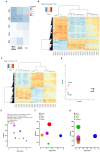Transcriptional and Epigenomic Markers of the Arterial-Venous and Micro/Macro-Vascular Endothelial Heterogeneity within the Umbilical-Placental Bed
- PMID: 36233172
- PMCID: PMC9569907
- DOI: 10.3390/ijms231911873
Transcriptional and Epigenomic Markers of the Arterial-Venous and Micro/Macro-Vascular Endothelial Heterogeneity within the Umbilical-Placental Bed
Abstract
Umbilical and placental vessels and endothelial cells (EC) are common models to study placental function and vascular programming. Arterio-venous differences are present in the umbilical endothelium; however, the heterogeneity of small placental vessels and the expression of potential micro- vs. macro-vascular (MMV) markers are poorly described. Here, we performed a meta-analysis of transcriptomic and DNA methylation data from placental and umbilical EC. Expression and methylation profiles were compared using hierarchical clustering, dimensionality reduction (i.e., tSNE, MDS, and PHATE), and enrichment analysis to determine the occurrence of arterio-venous (AVH) and micro-macro heterogeneity (MMH). CpG sites correlated with gene expression of transcriptional markers of MMH and AVH were selected by Lasso regression and used for EC discrimination. General transcriptional profile resulted in clear segregation of EC by their specific origin. MM and AVH grouping were also observed when microvascular markers were applied. Altogether, this meta-analysis provides cogent evidence regarding the transcriptional and epigenomic profiles that differentiate among EC, proposing novel markers to define phenotypes based on MM levels.
Keywords: endothelial; epigenetics; phenotypic heterogeneity; placenta; umbilical.
Conflict of interest statement
The authors declare that the research was conducted in the absence of any commercial or financial relationships that could be construed as a potential conflict of interest.
Figures






Similar articles
-
N-Acetylcysteine, a glutathione precursor, reverts vascular dysfunction and endothelial epigenetic programming in intrauterine growth restricted guinea pigs.J Physiol. 2017 Feb 15;595(4):1077-1092. doi: 10.1113/JP273396. Epub 2016 Dec 4. J Physiol. 2017. PMID: 27739590 Free PMC article.
-
Endothelial heterogeneity in the umbilico-placental unit: DNA methylation as an innuendo of epigenetic diversity.Front Pharmacol. 2014 Mar 27;5:49. doi: 10.3389/fphar.2014.00049. eCollection 2014. Front Pharmacol. 2014. PMID: 24723887 Free PMC article. Review.
-
Heterogeneity of microvascular endothelial cells isolated from human term placenta and macrovascular umbilical vein endothelial cells.Eur J Cell Biol. 2003 Apr;82(4):163-73. doi: 10.1078/0171-9335-00306. Eur J Cell Biol. 2003. PMID: 12751902
-
Early- and late-onset preeclampsia and the DNA methylation of circadian clock and clock-controlled genes in placental and newborn tissues.Chronobiol Int. 2017;34(7):921-932. doi: 10.1080/07420528.2017.1326125. Epub 2017 Jun 14. Chronobiol Int. 2017. PMID: 28613964
-
Novel insights for the role of nitric oxide in placental vascular function during and beyond pregnancy.J Cell Physiol. 2021 Dec;236(12):7984-7999. doi: 10.1002/jcp.30470. Epub 2021 Jun 14. J Cell Physiol. 2021. PMID: 34121195 Review.
Cited by
-
Flow in fetoplacental-like microvessels in vitro enhances perfusion, barrier function, and matrix stability.Sci Adv. 2023 Dec 22;9(51):eadj8540. doi: 10.1126/sciadv.adj8540. Epub 2023 Dec 22. Sci Adv. 2023. PMID: 38134282 Free PMC article.
-
In vitro examination of Piezo1-TRPV4 dynamics: implications for placental endothelial function in normal and preeclamptic pregnancies.Am J Physiol Cell Physiol. 2025 Jan 1;328(1):C227-C244. doi: 10.1152/ajpcell.00794.2024. Epub 2024 Dec 9. Am J Physiol Cell Physiol. 2025. PMID: 39652778 Free PMC article.
-
Transcriptional Profiling of Human Endothelial Cells Unveils PIEZO1 and Mechanosensitive Gene Regulation by Prooxidant and Inflammatory Inputs.Antioxidants (Basel). 2023 Oct 17;12(10):1874. doi: 10.3390/antiox12101874. Antioxidants (Basel). 2023. PMID: 37891953 Free PMC article.
References
-
- Gale N.W., Baluk P., Pan L., Kwan M., Holash J., DeChiara T.M., McDonald D.M., Yancopoulos G.D. Ephrin-B2 selectively marks arterial vessels and neovascularization sites in the adult, with expression in both endothelial and smooth-muscle cells. Dev. Biol. 2001;230:151–160. doi: 10.1006/dbio.2000.0112. - DOI - PubMed
Publication types
MeSH terms
Substances
Grants and funding
LinkOut - more resources
Full Text Sources
Research Materials
Miscellaneous

